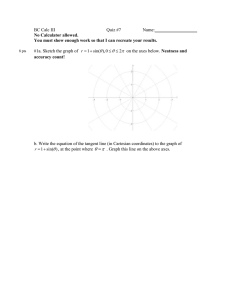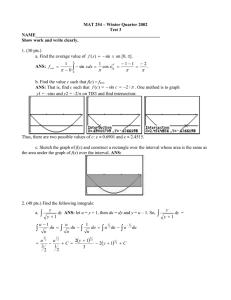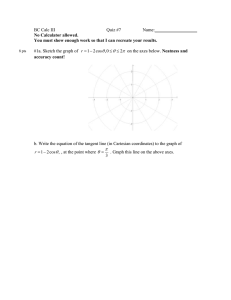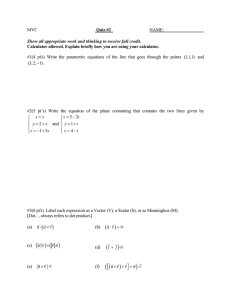Special Exam
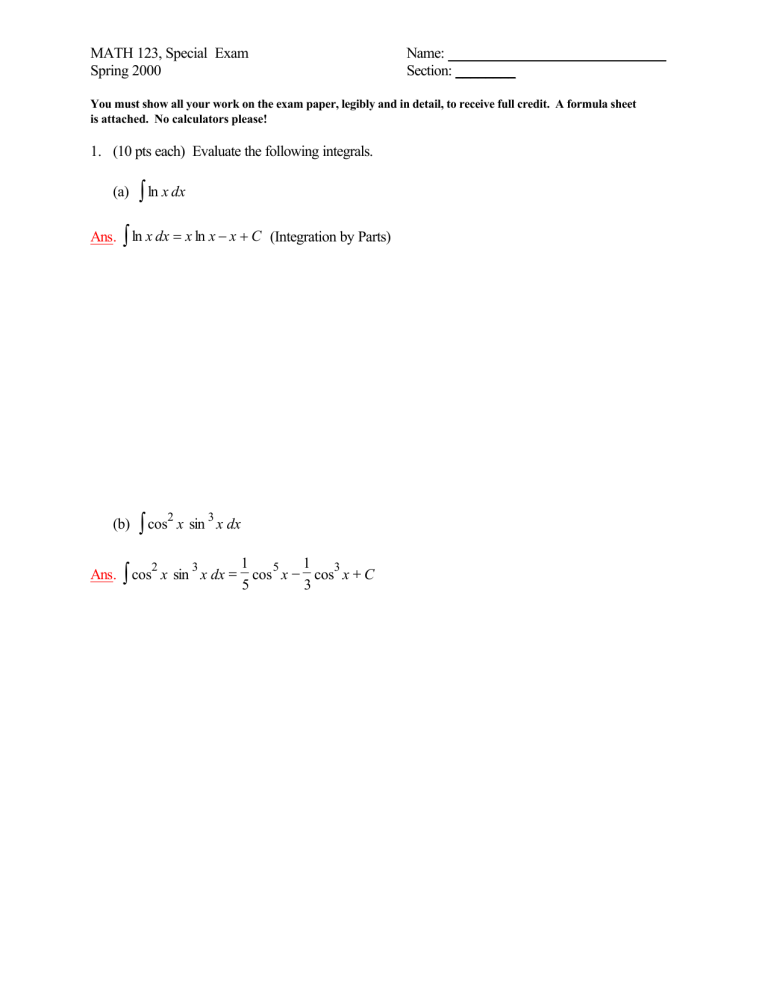
MATH 123, Special Exam
Spring 2000
Name: _____________________________
Section: ________
You must show all your work on the exam paper, legibly and in detail, to receive full credit. A formula sheet is attached. No calculators please!
1. (10 pts each) Evaluate the following integrals.
(a)
∫ ln x dx
Ans.
∫ x dx
= x ln x
− x
+
C (Integration by Parts)
∫ 2 x sin
3 x dx
Ans.
∫ 2 x sin
3 x dx
=
1
5 cos
5 x
−
1
3 cos
3 x
+
C
2. (15 pts) Use a partial fraction decomposition to evaluate
∫ 3 x
2 x ( x
+ x
+
1
2 +
1) dx .
Ans.
∫ 3 x
2 + x
+
1 x ( x
2 +
1) dx
= ∫
(
1 x
+
2 x + 1 x
2 +
1
) dx
= ln x
+ ln( x
2
+1) + tan
-1 x + C
3. (15 pts) Use a trigonometric substitution to find
∫
Ans.
∫ 1
9
+ x
2 dx
= ln
1
9
+ x
2 dx .
9
+ x
2
3
+ x
3
+
C or ln x
2 +
9
+ x
+
K
4. (10 pts) Use the axes provided to sketch the graph of the polar equation r
=
3sin 2
θ
.
Ans.
4-leaved rose (see figure)
5. (10 pts) Eliminate the parameter and use the axes provided to sketch the graph of the parametric curve x
=
2cos t , y
=
4 sin
2 t ; 0
≤ t
≤
2
π
. Describe the motion of the point
( x ( t ), y ( t ) ) as t varies in the given interval.
Ans.
The graph consists of the parabolic arch y
=
4
− x
2
,
−
2
≤ x
≤
2. As t varies in the given interval, the point traverses the arch from (2,0) to (–
2,0) and back to (2,0) again.
6. (15 pts) Find area of the region inside the lemniscate r r
=
2. Use the axes provided to sketch the region.
2 =
8cos 2
θ
and outside the circle
Ans.
A
=
4
π
6
0
∫ 1
2
[8 cos2
θ −
4 ] d
θ =
4 3
−
4
3
π
7. (15 pts) Find the arc length of the loop of the parametric curve x
=
1 t
3 −
3 t , y
= t
2
3 figure). [Note. As a first step you will need to determine the range of values of t that generate the loop.]
Ans.
The loop is traced (clockwise) as t varies through the interval
−
3
≤ t
≤
3.
3
L
=
2
∫
( t
0
2 −
3)
2 +
( 2 t 3)
2 dt
=
36
3 (see
Basic Trigonometric Identities
MISCELLANEOUS FORMULAS cos
2 θ + sin
2 θ =
1 cos
2 θ =
1
− sin
2 θ
1
+ tan
2 θ = sec
2 θ tan
2 θ = sec
2 θ −
1
Double-Angle and Half-Angle Formulas sin 2
θ =
2sin
θ cos
θ cos2
θ = cos
2 θ − sin
2 θ cot
2 θ +
1
= csc
2 θ cot
2 θ = csc
2 θ −
1 cos
2 θ =
1
2
(1
+ cos2
θ
) sin
2 θ =
1
2
(1
− cos2
θ
)
Polar Coordinates x
= r cos
θ y
= r sin
θ r
2 = x
2 + y
2 tan
θ = y x
A
=
β
α
∫ 1
2 r
2 d
θ
A
=
β
α
∫ 1
2
[( r outer
)
2 −
( r inner
)
2
] d
θ
Parametric Curves dy dx
V x
= dy dt dx dt d
2 y dx
2
= d y
′
= dx d y
′ dt dx
β
L
= ∫
(
α dt
∫ b a
β
A
= ydx
= y ( t ) x
′
( t ) dt
α
∫ dx dt b
= ∫ π y a
β
2 dx
= π y ( t )
2
α
∫ ′
( t ) dt V y
)
2 +
( dy dt
)
2 dt a
∫ b
β
=
2
π xydx
=
2
π x ( t ) y ( t ) x
′
( t ) dt
α
∫
